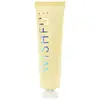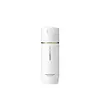What's inside
What's inside
 Key Ingredients
Key Ingredients

 Benefits
Benefits

 Concerns
Concerns

 Ingredients Side-by-side
Ingredients Side-by-side

Water
Skin ConditioningCellulose
AbsorbentButylene Glycol
HumectantPropylene Glycol
HumectantAlcohol
Antimicrobial1,2-Hexanediol
Skin ConditioningBromelain
Skin ConditioningAnanas Sativus Fruit Extract
Skin ConditioningPapain
Skin ConditioningCarica Papaya Fruit Extract
Skin ConditioningCitric Acid
BufferingLactic Acid
BufferingMalic Acid
BufferingSalicylic Acid
MaskingTartaric Acid
BufferingGlycolic Acid
BufferingZingiber Officinale Root Extract
MaskingGlycerin
HumectantRosa Centifolia Flower Extract
AstringentCocos Nucifera Fruit Extract
EmollientPrunus Amygdalus Dulcis Oil
Skin ConditioningSalix Alba Bark Extract
AstringentSaccharum Officinarum Extract
MoisturisingAcer Saccharum Extract
Skin ConditioningCamellia Japonica Leaf Extract
Skin ConditioningCitrus Paradisi Seed Extract
MaskingPhellodendron Amurense Bark Extract
Skin ConditioningMannitol
HumectantPsidium Guajava Leaf Extract
AstringentCamellia Sinensis Leaf Extract
AntimicrobialMangifera Indica Fruit Extract
Skin ConditioningMusa Sapientum Fruit Extract
Skin ConditioningPassiflora Edulis Fruit Extract
Skin ConditioningCitrus Aurantium Dulcis Fruit Extract
MaskingCitrus Limon Fruit Extract
MaskingVaccinium Myrtillus Fruit Extract
Skin ConditioningMagnolia Officinalis Bark Extract
AntimicrobialSodium Hyaluronate
HumectantEthylhexylglycerin
Skin ConditioningGluconolactone
Skin ConditioningPolysorbate 20
EmulsifyingCarbomer
Emulsion StabilisingTromethamine
BufferingPropanediol
SolventDisodium EDTA
Phenoxyethanol
PreservativeBenzyl Alcohol
PerfumingParfum
MaskingWater, Cellulose, Butylene Glycol, Propylene Glycol, Alcohol, 1,2-Hexanediol, Bromelain, Ananas Sativus Fruit Extract, Papain, Carica Papaya Fruit Extract, Citric Acid, Lactic Acid, Malic Acid, Salicylic Acid, Tartaric Acid, Glycolic Acid, Zingiber Officinale Root Extract, Glycerin, Rosa Centifolia Flower Extract, Cocos Nucifera Fruit Extract, Prunus Amygdalus Dulcis Oil, Salix Alba Bark Extract, Saccharum Officinarum Extract, Acer Saccharum Extract, Camellia Japonica Leaf Extract, Citrus Paradisi Seed Extract, Phellodendron Amurense Bark Extract, Mannitol, Psidium Guajava Leaf Extract, Camellia Sinensis Leaf Extract, Mangifera Indica Fruit Extract, Musa Sapientum Fruit Extract, Passiflora Edulis Fruit Extract, Citrus Aurantium Dulcis Fruit Extract, Citrus Limon Fruit Extract, Vaccinium Myrtillus Fruit Extract, Magnolia Officinalis Bark Extract, Sodium Hyaluronate, Ethylhexylglycerin, Gluconolactone, Polysorbate 20, Carbomer, Tromethamine, Propanediol, Disodium EDTA, Phenoxyethanol, Benzyl Alcohol, Parfum
Mannitol
HumectantSodium Cocoyl Glycinate
CleansingSodium Lauroyl Glutamate
Zeolite
AbsorbentSilica
AbrasiveBetaine
HumectantAllantoin
Skin ConditioningPotassium Laurate
EmulsifyingPolycaprolactone
StabilisingParfum
MaskingZea Mays Starch
AbsorbentPEG-75
HumectantDipotassium Glycyrrhizate
HumectantDisodium EDTA
Trehalose
HumectantWater
Skin ConditioningButylene Glycol
HumectantPapain
Skin ConditioningLactobacillus Ferment Lysate
Skin ConditioningCI 19140
Cosmetic ColorantZingiber Officinale Root Extract
MaskingZiziphus Jujuba Fruit Extract
Skin ConditioningCamellia Sinensis Leaf Extract
AntimicrobialMannitol, Sodium Cocoyl Glycinate, Sodium Lauroyl Glutamate, Zeolite, Silica, Betaine, Allantoin, Potassium Laurate, Polycaprolactone, Parfum, Zea Mays Starch, PEG-75, Dipotassium Glycyrrhizate, Disodium EDTA, Trehalose, Water, Butylene Glycol, Papain, Lactobacillus Ferment Lysate, CI 19140, Zingiber Officinale Root Extract, Ziziphus Jujuba Fruit Extract, Camellia Sinensis Leaf Extract
 Reviews
Reviews

Ingredients Explained
These ingredients are found in both products.
Ingredients higher up in an ingredient list are typically present in a larger amount.
Butylene Glycol (or BG) is used within cosmetic products for a few different reasons:
Overall, Butylene Glycol is a safe and well-rounded ingredient that works well with other ingredients.
Though this ingredient works well with most skin types, some people with sensitive skin may experience a reaction such as allergic rashes, closed comedones, or itchiness.
Learn more about Butylene GlycolCamellia Sinensis Leaf Extract is derived from the leaves of the tea plant. Black tea, green tea, and oolong tea are all harvested from this plant.
This ingredient has many skin benefits:
This ingredient contains polyphenols, a strong antioxidant. Antioxidants help fight off molecules that damage skin cells.
On top of that, the antioxidants in green tea neutralize free-radicals from the sun. This gives the skin some extra UV protection, but should not replace sunscreen.
Many components of tea have anti-inflammatory properties.
Polyphenols and L-theanine help soothe the skin and reduce irritation. The caffeine in Camellia Sinensis Leaf Extract helps calm inflamed blood vessels.
Other compounds found in tea include: Vitamin Bs, linoleic acid, magnesium, calcium, iron, and zinc.
Research has shown both drinking Camellia Sinensis Leaf Tea and applying it to the skin can help boost skin elasticity and hydration. Studies also show using tea extract may reduce sebum, or oil, production.
Learn more about Camellia Sinensis Leaf ExtractDisodium EDTA plays a role in making products more stable by aiding other preservatives.
It is a chelating agent, meaning it neutralizes metal ions that may be found in a product.
Disodium EDTA is a salt of edetic acid and is found to be safe in cosmetic ingredients.
Learn more about Disodium EDTAMannitol is a sugar alcohol. It is a humectant and moisturizes the skin. In vitro (not tested on a living organism), mannitol displays antioxidant properties.
When found in aqueous solutions, mannitol tends to become acidic. This is because it loses a hydrogen ion. This is why mannitol can often be found with pH adjusting ingredients, such as sodium bicarbonate.
Fun fact: Mannitol can be found in foods as a sweetener. It can be naturally found in mushrooms, algae, fruits, and veggies.
Learn more about MannitolPapain is an enzyme found naturally in the papaya plant's leaves, fruit, and roots. It has antimicrobial, soothing, and wound healing properties.
Glycine and Vitamin A are naturally found in papain.
While papain is often touted as skin-lightening, further studies are needed to prove this. However, papain has been shown to help soothe acne-inflammation.
Papain belongs to a class of enzymes called proteolytic enzymes. These enzymes break down peptides and amino acids.
Some studies found papain to be a potential skin sensitizer and allergen. Those with latex allergies might also be allergic to papaya.
Learn more about PapainParfum is a catch-all term for an ingredient or more that is used to give a scent to products.
Also called "fragrance", this ingredient can be a blend of hundreds of chemicals or plant oils. This means every product with "fragrance" or "parfum" in the ingredients list is a different mixture.
For instance, Habanolide is a proprietary trade name for a specific aroma chemical. When used as a fragrance ingredient in cosmetics, most aroma chemicals fall under the broad labeling category of “FRAGRANCE” or “PARFUM” according to EU and US regulations.
The term 'parfum' or 'fragrance' is not regulated in many countries. In many cases, it is up to the brand to define this term.
For instance, many brands choose to label themselves as "fragrance-free" because they are not using synthetic fragrances. However, their products may still contain ingredients such as essential oils that are considered a fragrance by INCI standards.
One example is Calendula flower extract. Calendula is an essential oil that still imparts a scent or 'fragrance'.
Depending on the blend, the ingredients in the mixture can cause allergies and sensitivities on the skin. Some ingredients that are known EU allergens include linalool and citronellol.
Parfum can also be used to mask or cover an unpleasant scent.
The bottom line is: not all fragrances/parfum/ingredients are created equally. If you are worried about fragrances, we recommend taking a closer look at an ingredient. And of course, we always recommend speaking with a professional.
Learn more about ParfumWater. It's the most common cosmetic ingredient of all. You'll usually see it at the top of ingredient lists, meaning that it makes up the largest part of the product.
So why is it so popular? Water most often acts as a solvent - this means that it helps dissolve other ingredients into the formulation.
You'll also recognize water as that liquid we all need to stay alive. If you see this, drink a glass of water. Stay hydrated!
Learn more about WaterZingiber Officinale is more commonly known as ginger.
Ginger root has antioxidant, anti-inflammation, and antimicrobial properties.
The antioxidant properties help protect your body from free-radicals. Free-radicals are molecules that may damage your skin cells. As a result, ginger may help slow down signs of aging such as hyperpigmentation and wrinkles.
Studies show ginger inhibits the enzyme that breaks down collagen. It also helps with:
This ingredient has no negative side-effects and is safe to use unless one has a specific allergy to it.
Ginger originates from Southeast Asia but has spread throughout the world. It is now a common spice used in many cultures.
Learn more about Zingiber Officinale Root Extract